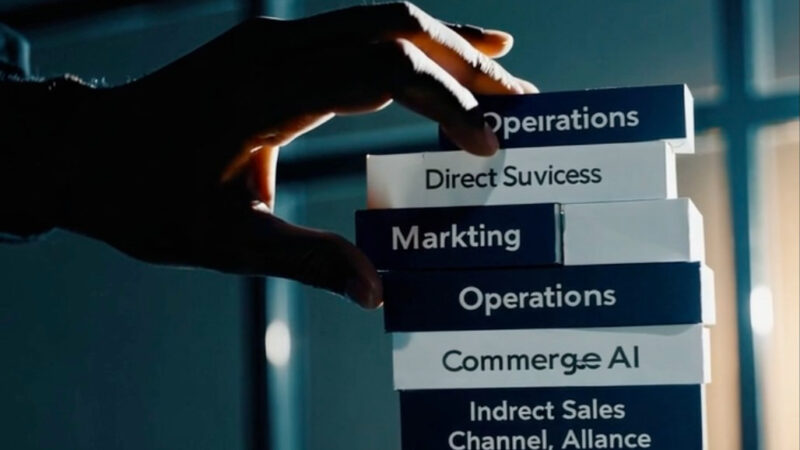Marketing at an AI Company
Marketing at Conversica (The Wins)
I had committed to 5 years, and even though I didn’t envision it taking as long as it did, we finally achieved most of what we originally set out to accomplish back in October 2019.
Conversica’s marketing evolution was a case study in category creation through strategic storytelling, demand discipline, and thoughtful reframing of value. The team transformed marketing from a lead-generation function into a catalyst for Conversica’s AI GTM strategy.
The first major breakthrough came with the decision to reframe the Conversica brand away from chatbots. In a world crowded with simple one-way chat interfaces, Conversica’s AI-powered agents were fundamentally different—capable of multi-turn, human-like conversations that spanned the funnel and beyond. Yet the market couldn’t always see that distinction. The answer? A bold repositioning. Through refined messaging and visual identity, Conversica staked its claim not as a chatbot company (e.g. Drift), but as the pioneer of “AI Workforce” automation—technology that could reshape how enterprises approached engagement, at scale and focused on boosting revenue (unlike its peers in cost-reduction focused use-cases).
Two big ideas helped anchor this transformation: the New Marketing Funnel and the Conversation Gap. These concepts tapped into a deep pain in the marketing and sales universe—the inability to engage every prospect, at the right time, with the right message. Conversica positioned its AI not as automation for automation’s sake, but as the bridge over the funnel’s silent chasms: the missed opportunities, ignored inquiries, and stale leads.
The team amplified these concepts through customer storytelling and ROI modeling. Rather than lead with technical features or sweeping promises, Conversica’s marketing motion zeroed in on very specific pain points and paired them with human narratives. Once engaged, buyers were shown hard value through detailed, customized ROI calculators—factoring in both revenue lift and “hours saved” through workforce augmentation. The team led with boosted pipeline and ultimately sales, followed with cost savings, all proven by using 12 months of trailing data for similar customers using the same use-cases. Data doesn’t lie.
By 2025, marketing had become a strategic weapon. It spoke the language of customers, bridged the gap between product and sales, and gave Conversica an unmistakable voice in a noisy market. The company achieved the #1 position with Forrester in Conversation Automation Solutions for B2B in 2024.
Marketing – Strategic Headwinds (The Losses)
Despite bold vision and clear ROI, marketing at Conversica faced structural barriers to broader adoption—particularly in large enterprise environments.
- Transformation Was Too Big a Leap for Most Enterprises
While Conversica’s value proposition resonated with CMOs and demandgen leaders, the broader vision—rearchitecting entire workforces around AI—was often too much for organizations to absorb. Even with 50x ROI in marketing deployments, cross-functional expansion rarely happened organically beyond Marketing as the first sponsor. Sales, Customer Success, and Revenue Operations teams were resistant to change, clinging to human-owned workflows despite the proven economic upside. - Enterprise-Wide Adoption Never Became Repeatable
Despite lighthouse wins, Conversica couldn’t reliably trigger enterprise-wide deployments (from North America into other F500 regions: LATAM, EMEA, APAC, proved to be challenging). As already said, even though Marketing often served as the “Trojan horse,” this rarely catalyzed viral adoption, moving from Marketing to Sales to Customer Success, within customer accounts. The challenge wasn’t value, especially with bigger organizations—it was inertia. Getting multiple departments aligned on an AI-driven model proved too complex, too political, and too new. - Vision vs. Boardroom Translation Gap
Investors and board members often failed to grasp the nuance of Conversica’s category innovation, and what it took to penetrate the hearts and minds of our buyers. The conversation gap, funnel automation, and AI engagement needed to be translated into CFO- and CEO-grade ROI terms—overall topline business impact, hard dollar savings, and budget justification. The team learned to tell different stories: one for the visionary buyer, and one for the financially-driven approver.
These obstacles didn’t negate marketing’s success—but they did limit its potential. Conversica’s marketing engine was visionary and effective, but still struggled to turn transformational excitement into frictionless enterprise rollout.
Advice From One CEO to Another – Building Marketing in AI GTM
- Define the Category—Then Own It
Don’t compete as a better widget. Create a new frame. Conversica didn’t sell chatbots—it sold the AI Workforce. Your category is the battlefront. Also, everyone has AI now. Why is your APPLICATION of it different? - Narratives First, Metrics Second
Big ideas like the “conversation gap” give your GTM emotional punch. But always back them with ROI frameworks—custom calculators that make value undeniable. People didn’t care about “engagement”. They cared about pipeline and ultimately revenue. - Land Narrow, Expand Carefully
Start with surgical precision—solve one painful use case for one team that delivers the most value, early. Don’t sell enterprise transformation on day one. Add scale only after success. - Use Customer Stories as Proof, Not Just Promotion
Show—not tell—the journey from status quo to AI-powered results. Build your funnel on credibility, not claims. Use value adoption models (maturity models) to present a roadmap for customers. Start with 30M and then here’s the roadmap to 1B in pipeline generation from AI. - Train for CFO Conversations
Translate vision into value. Teach marketing to speak in boardroom terms: AI workforce ROI, added revenue, cost replacement, cost per lead, cost per customer acquired. Vision needs a spreadsheet to get funded. - Don’t Count on Viral Adoption
Inertia is strong. Build post-sale programs and internal champion toolkits to systematically drive cross-functional expansion. The customer community needs to help sell. - The Best Marketing Uses the Product
Conversica on Conversica wasn’t just a slogan—it was a strategy. Every CMO pitch gets stronger when your own team uses the tool. Show how it changes your funnel.
Strategy isn’t built in slides. It’s forged in hard conversations, late-night pivots, and the messy middle of execution. Every bold move we made as a company lived or died by the strength of our executive team. What follows isn’t just my perspective—it’s the collective experience of those who were in the trenches. The functional leaders who owned the inflection points. Who navigated the trials, learned from the misfires, and helped turn strategy into motion. This is what transformation really looks like—function by function, leader by leader, decision by decision.
- Executive Team Management
- Direct Sales
- Indirect Sales / Channel / Alliances
- Marketing
- Customer Success Management
- Technical / Customer Support
- Professional Services
- Product Management
- R&D
- Cloud Operations / DevSecOps
- Legal / Security / Compliance
- HR / People
- Finance
- International Operations
- Corporate Development
- Board Management



